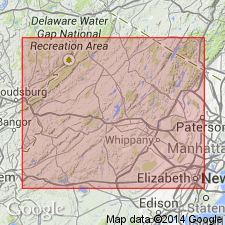
- Usage in publication:
-
- Vernon Supersuite*
- Modifications:
-
- Named
- Dominant lithology:
-
- Granite
- Alaskite
- Syenite
- Monzonite
- AAPG geologic province:
-
- Appalachian basin
- Piedmont-Blue Ridge province
Summary:
Vernon Supersuite named for Vernon Township, Sussex Co., northern NJ. Applies to abundant and diverse rocks of Byram and Lake Hopatcong Intrusive Suites from Hamburg Mountains, Hamburg 7.5-min quad, Vernon Township. [The name Hamburg Mountains was preoccupied by another unit.] Although the name Vernon has already been applied to the Silurian Salina Shale of NY, these two units are not named for the same feature and there is a great enough disparity in age so that there should be no confusion. Byram consists of hornblende granite, microperthite alaskite, hornblende quartz syenite, syenite, hornblende granite, hornblende monzonite, and quartz monzonite. Lake Hopatcong rocks include granite, quartz monzonite, monzonite, granodiorite, and quartz monzogranodiorite. Byram and Hopatcong are cogenetic and comagmatic, an interpretation supported by field relationships and geochemical relationships. Age is Middle Proterozoic.
Source: GNU records (USGS DDS-6; Reston GNULEX).
For more information, please contact Nancy Stamm, Geologic Names Committee Secretary.
Asterisk (*) indicates published by U.S. Geological Survey authors.
"No current usage" (†) implies that a name has been abandoned or has fallen into disuse. Former usage and, if known, replacement name given in parentheses ( ).
Slash (/) indicates name conflicts with nomenclatural guidelines (CSN, 1933; ACSN, 1961, 1970; NACSN, 1983, 2005, 2021). May be explained within brackets ([ ]).

